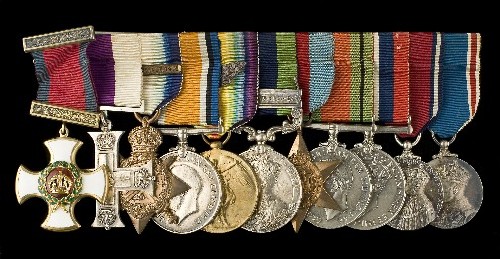
Auction: 9022 - Orders, Decorations, Medals & Militaria
Lot: 5
x A Second War ´1940´ C.B.E., Great War ´Mesopotamia´ D.S.O., ´1915, French Theatre´ M.C. Group of Twelve to Brigadier-General H.W.R. "Hamie" Hamilton, Royal Engineers, Twice Mentioned in Despatches for Waziristan, 1921-24; Commanded Royal Bombay Sappers and Miners, 1935-38, And a Veteran of Dunkirk a) The Most Excellent Order of British Empire, 2nd type, Military Division, Commander´s (C.B.E.) neck Badge, silver-gilt and enamel, with full neck riband b) Distinguished Service Order, G.V.R., silver-gilt and enamel, minor enamel damage to reverse centre, with integral top-riband bar c) Military Cross, G.V.R., unnamed as issued d) 1914 Star, with Bar (Lieut. H.W.R. Hamilton, R.E.) e) British War and Victory Medals, M.I.D. Oakleaves (Capt. H.W.R. Hamilton.) f) India General Service 1908-35, G.V.R., one clasp, Waziristan 1921-24 (Capt. H-W-R. Hamilton, R.E.) g) 1939-1945 Star h) Defence and War Medals i) Jubilee 1935 j) Coronation 1937, light contact marks overall, generally very fine, breast awards mounted as originally worn, with extensive research and a number of photographic images of recipient from varying stages of his life and a copy of History of the 20th (Field) Company Royal Bombay Sappers & Miners Great War: 1914-1918, by the recipient(12) Estimate £ 2,500-3,000 C.B.E. London Gazette 11.7.1940 Colonel Hugh William Roberts Hamilton, D.S.O., M.C., Late Royal Engineers D.S.O. London Gazette 25.8.1917 ´´For Distinguished Service in the Field in Mesopotamia´´ M.C. London Gazette 14.1.1916 Lieutenant Hugh William Roberts Hamilton, Royal Engineers Brigadier-General Hugh William Roberts Hamilton, C.B.E., D.S.O., M.C. (1892-1959), born Dalhousie, India, son of Brigadier-General W.G. Hamilton, C.B., C.S.I., D.S.O., and his wife Mary Gough, as such he was the grandson of General Sir Hugh Henry Gough, V.C.; educated at Rugby School; commissioned Second Lieutenant Royal Engineers, 1911; Lieutenant 24.11.1913; served with the 20th (Field) Company, 3rd Bombay Sappers and Miners in the French theatre of War, from 2.11.1914; in March 1915 Hamilton´´s unit moved to Neuve Chappelle, and during the attack on Neuve Chappelle on the 12th March, the company was employed in carrying ammunition to the front line - Hamilton was wounded and evacuated from the front line area; he rejoined his company, 13.4.1915, at Bout de Ville, in time for the Second Battle of Ypres (M.I.D. London Gazette 1.1.1916); travelled with the 3rd Sappers and Miners for service in Mesopotamia, and arrived at Kut-Al-Amarah, 20.4.1916; served at Twin Canals, and during that time the unit invented a bomb-trap, centred around a Mills grenade - ironically Hamilton was the first casualty caused by the invention, injured whilst attaching the mechanism to wire, he spent a month in hospital; the unit was attached to the 8th Infantry Brigade for offensive operations, December 1916; the following month the company took part in the assault on the Muhammad Abdul Hassan Bend, and in February they were involved in the river crossing operations on the Tigris at Shumran; Hamilton took command of the 20th Company, April 1917, and the following month commanded the company in the construction of bridgehead defences at Barurah; Captain 26.6.1917 (D.S.O.; M.I.D. London Gazette 25.8.1917); served as Adjutant with the Staff of the Commander Royal Engineers in Palestine, May-June 1918; rejoined the 3rd Sappers and Miners, as part of the Egyptian Expeditionary Force, from September 1918; Acting Major 1.11.1918; served with the 20th Company in Waziristan, from 1922 (Twice Mentioned in Despatches London Gazette 30.5.1924 and 16.12.1924); Major 26.9.1926; returned to England before being assigned as a General Staff Officer to the Staff of General Sir Alexander J. Godley, Governor and Commander-in-Chief, Gibraltar, from 2.3.1931; rejoined Royal Bombay Sappers and Miners in India, 1933; Lieutenant-Colonel 24.9.1934, and the following year was Officer Commanding of the Regiment; almost immediately engaged in disaster relief in and around Quetta, after an awful earthquake befell the city; Colonel 24.9.1937; returned to England to take up a Staff position in 1938; he was recalled to active service with the outbreak of the Second World War, and in May 1940, went to France as a Staff Officer with the 4th Division, II Corps; during the 18-19th May the division made it´´s withdrawal from the Dyle River Line, and the 26th May it made it´´s final withdrawal into the Dunkirk Perimeter; Hamilton was present during the defence and final evacuation of Dunkirk, 30th-31st May (C.B.E.-which he received at Buckingham Palace, 6.8.1940); later postings included Deputy Commander, Nottingham Sub-District; retired Brigadier-General 11.9.1946; in later life he resided in Newport Pagnell, Buckinghamshire, and wrote an account of his Great War Service "History of the 20th (Field) Company, Royal Bombay Sappers and Miners, Great War: 1914-1918.
Sold for
£4,200




